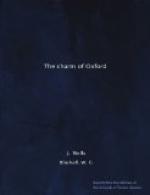The hand of the “restorer” has been active at Christ Church, as elsewhere in Oxford; Gilbert Scott took on himself to remove a fine fourteenth-century window from the east end of the choir, and to substitute the Norman work shown in Plate I. The effect is admittedly good, but it may be questioned whether it be right to falsify architectural history in this way.
Oxford Cathedral has great associations apart from the college to which it belongs. It was to it that Cranmer was brought to receive the Pope’s sentence of condemnation, and in the cloisters the ceremony of his degradation from the archbishopric was carried out. Almost a century later the Cathedral was the centre of the religious life of the Royalist party; when Charles I made his capital in Oxford and his home in Christ Church, and when the Cavaliers fought to the war-cry of “Church and King.” It is not surprising that, when the Parliamentarians entered Oxford, the windows of the Cathedral were much “abused”; that so much old glass was spared was probably due to the local patriotism of old Oxford men.
In the next century it was to Christ Church that Bishop Berkeley, the greatest of British philosophers, retired to end his days, and to find a burial-place; and, during the long life of Dr. Pusey, the Cathedral of Oxford was a place of pilgrimage, as the living centre of the Oxford movement.
In the back of the picture (Plate XVII), behind the
Cathedral, rises the square tower, put up by Mr. Bodley
to contain the famous Christ Church peal of bells
(now twelve in number), familiar through Dean Aldrich’s
famous round, “Hark, the bonny Christ Church
bells.” When the tower was erected, it
was the subject of much criticism, especially from
the witty pen of C. L. Dodgson, the world-famous creator
of Alice in Wonderland. The opening paragraph
is a fair specimen:
“Of the etymological
significance of the new belfry, Christ
Church.
“The word ‘belfry’
is derived from the French ’bel—
beautiful,
meet,’ and from the German ‘frei—free,
unfettered, safe.’ Thus the word is strictly
equivalent to ‘meat-safe,’ to which the
new belfry bears a resemblance so perfect as almost
to amount to coincidence.”
Others saw in the uncompromising squareness of the new tower a subtle compliment to the Greek lexicon of Liddell, who then was Dean. But in spite of the wits, who resented any innovation in so famous a group of buildings, Bodley’s tower is a fine one, and really enhances the effect of Tom Quad.
CHRIST CHURCH (2) THE HALL STAIRCASE
“And love the high-embowed
roof
With antique pillars
massy proof.”
MILTON
[Plate XVIII. Christ Church : The Hall Staircase]
When Wolsey began to build what he intended to be the most splendid college in the world, the first part to be finished was the dining-hall, with the kitchen. The wits of the time made very merry at this: their epigram Egregium opus! Cardinalis iste instituit collegium et absolvit popinam may be rendered:




